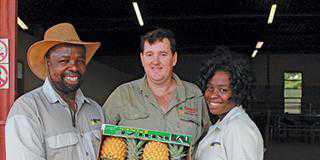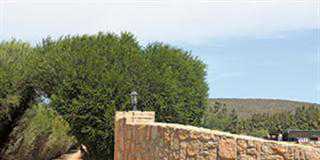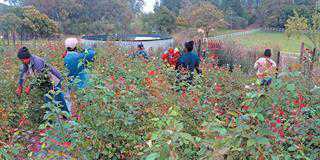Zimbabwean expatriate Paul Hanly has persevered since he began promoting local katambora rhodes grass seed production for export to the Middle Eastern dairy industry.
Now the South African katambora industry is on the verge of achieving critical export mass for this niche product. Lloyd Phillips reports on the latest developments.
Following a Farmer’s Weekly article in the 12 November 2004 issue, on his initiative to establish widespread katambora seed production in South Africa, Paul Hanly was inundated with queries from farmers all over the country. They were keen to participate in trials to determine if this potentially lucrative niche product would make them some money.
As with all trials, there have been some farmers who have stayed the distance over the two years of getting katambora seed production up and running. Others, for whatever reason, decided that this idea was not for them. “After the article, I had enquiries from people as far afield as Tanzania who were interested in contract growing katambora seed for my business, Agri-Warehouse SA,” says Paul.
“After two years, we now have about 1 000ha of land under katambora in SA, but are still looking for people to help increase this area to between 2 500ha to 3 000ha to achieve a viable quantity and quality of seed for export.” What is katambora? The Rhodes grass (Chloris gayana) cultivar katambora is indigenous to Southern Africa. It is tolerant of warm temperatures and saline soils, is highly palatable to both equines and ruminants, and therefore, in great demand by the dairy industries of hot and dry Middle East countries such as Saudi Arabia and the United Arab Emirates.
Unfortunately for these countries, their extremely high temperatures prevent them from producing their own katambora seed. This is where South Africa’s farmers can fill the demand. Paul’s trials have shown it is difficult to grow katambora in his home province, KwaZulu-Natal because topography keeps field sizes small and makes combine harvesting the seed an expensive and unattractive option. Therefore, Agri-Warehouse SA is now focusing on katambora production in the Highveld region of SA where fields are flatter and larger.
“Contract harvesters are not too keen to go through the hassle of configuring their combines to harvest a mere 20ha of typical katambora seed crop. Apart from it costing a farmer more to have katambora combined than for larger grain crops, it is essential that contract harvesters are available at short notice to harvest a katambora seed crop or the seeds will start dropping to the ground. This has been a problem with using contractors,” Paul explains. “With the relatively small areas that farmers have under katambora, it has been financially impractical for them to buy an expensive combine harvester.”
In response to this harvesting problem, Agri-Warehouse SA has developed the Chauni Seedmaster for farmers who want to harvest katambora effectively, and a range of other seed crops without hiring or buying an expensive combine harvester. Designed and constructed locally, the Chauni can harvest seed from smuts finger grass, ryegrasses, eragrostis and others. Based on an idea by Carltonville katambora contract grower Nick van der Merwe, the Chauni is tractor-towed and has a wheel, gear and chain-driven rotating drum and beater system that knocks mature dry seed off the plant and into a holding drum.
Unlike combine harvesters, the Chauni doesn’t cut the plant’s head off or harvest immature seed. Due to its design, it only takes off the seed that is ready and leaves immature seed on the plant to dry and mature ahead of a second harvesting run a few days later. Paul says, “An important advantage of the way the Chauni harvests the seed is that the final product has a higher germination rate than if both mature and immature seed were harvested together. By being able to leave the remaining immature seed for a few days until it is ready for harvesting, we can increase the germination rate of our product by up to about 5%. Then the katambora seed can be sold for a better price, and our clients will be satisfied with the quality of our product.”
Chauni Seedmaster specs The rotating drum has an operating width of 4,2m, and is driven by a simple gear and chain system turned by the tractor’s ground speed. The drum consists of six mild steel and rubber paddles that effectively flick the grass seed into the bin as the Chauni passes through the land. The Chauni’s storage bin can hold approximately 200kg of grass seed, and can either dump the seed load onto a bagging surface or offload the seed directly into bags. The Chauni Seedmaster can harvest 8ha to 10ha per day, dependent on the seed crop density and the tractor’s ground speed.
The machine comes with a range of cog sizes that can easily be changed to achieve the ideal drum rotation speed for harvesting. The rotating drum distance from the storage bin can be set from 10mm to 180mm vertically or horizontally. Including the drawbar, the implement has an overall length of 3,765m, a transport width of 3,28m, an overall operating width of 4,2m, and a transport height of 1,55m. An interesting aspect of the Chauni Seedmaster’s design is that, during harvesting, its adjustable offset drawbar allows the machine to operate slightly behind and next to the tractor that is pulling the machine. Therefore, on the first harvesting run, the tractor doesn’t drive over unharvested plants, which means less seed loss caused by the wheels. By the time the crop is ready for harvesting again a few days later, any trampled grass is likely to have recovered.
“The Chauni Seedmaster is currently available directly from Agri-Warehouse SA for R42 000, excluding VAT and delivery, and comes with a one year workmanship warranty. This implement will be available through TWK Agriculture in future,’ says Paul. “A farmer who buys a Chauni and uses it to harvest 20ha of katambora per year or other grass seed for three seasons will be able to pay it off by the end of, or within, that time.” For more information on how to become a katambora seed contract grower, contact Paul Hanly on (033 082 217 5407, (033) 263 1309, fax 1064 or e-mail [email protected]. |FW













